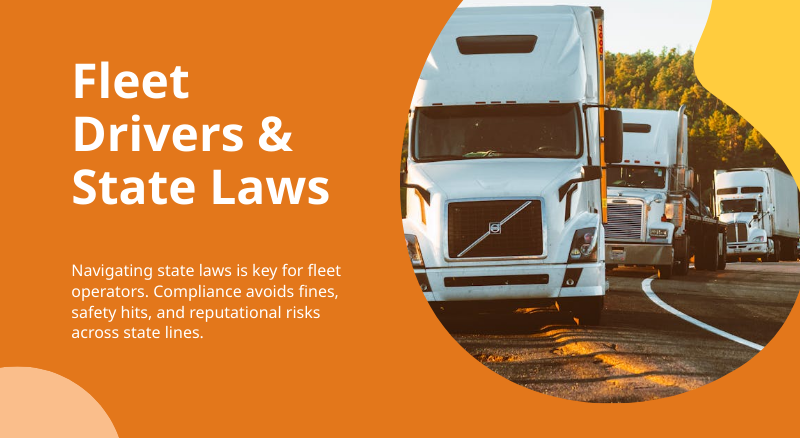Fleet Drivers & U.S. State Law: Why It Matters
Fleet operators tend to manage broad interstate corridors—but legal compliance doesn’t “average out.” The moment a driver crosses a state line, or hits a county or city boundary, the applicable regulations may shift. A citation for a relatively small infraction—say, idling too long, failing to “move over,” or using a handheld phone—can cascade into:
-
fines and delays
-
CSA or safety score hits
-
insurance cost increases
-
reputational risk (especially in municipal or city-sensitive contracts)
In 2025, the most impactful state-level rules for fleet drivers cluster in four areas:
-
Anti-idling / idle reduction limits
-
Hands-free / distracted-driving bans
-
“Move Over” / slow-down requirements for stopped vehicles
-
Winter traction / chain / snow condition rules
Below, I dive into each, highlight key state or regional variation, and offer policy best practices.
1. Anti-Idling Laws & Idle-Reduction Rules
Why idle rules matter for fleets
-
Engines left running burn fuel (and cost money).
-
Emissions from idling attract regulatory scrutiny, especially in urban or pollution zones.
-
Violations are enforceable by local or state agencies at roadside or during inspections.
Landscape of anti-idling regulation
-
Roughly 30 states plus the District of Columbia have some legal restriction on vehicle idling.
-
But those rules differ wildly in how long idle is permitted, which vehicles are covered, and what exemptions apply.
-
Many states rely on local or county-level ordinances layered on top of state limits.
Examples of variation
-
Massachusetts: Idling beyond five minutes is prohibited, except in defined “necessary” scenarios (e.g., extreme weather, engine warm-up).
-
Texas: Heavy-duty vehicles in jurisdictions that have signed MOAs with the state can be limited to 5 minutes of idling when not in motion
-
Some states (like Illinois, South Carolina, Nevada, West Virginia) allow 14–15 minutes in certain contexts.
Operational risks and pitfalls
-
A single overnight stop in a jurisdiction with a strict 5-minute rule (versus a 15-minute elsewhere) can incur a citation.
-
Local “no-idle zones” (e.g. near schools, hospitals, loading bays) may override broader state rules.
-
Exemptions (weather, traffic, PTO use, sleeper cab) need explicit codification in driver training or policy.
2. Hands-Free / Distracted Driving Laws
The federal baseline + state overlay
-
Commercial drivers operating under federal rules (FMCSA) already face strict prohibitions on handheld device use.
-
Many states extend hands-free mandates to all drivers, or layer additional constraints (for young drivers, school zones, etc.).
-
As of 2025, 30 states + D.C. have “hands-free” laws banning use of handheld devices while driving.
Key elements of variation
-
Primary vs secondary enforcement: In some states, police can stop a driver solely for device violations; in others, another violation is required.
-
Complete “touch ban” vs limited use: Some newer laws prohibit any contact (even while stopped), unless in emergencies.
-
Exemptions: Emergency responders, public safety, permitted in “hands-free” mode, or when parked.
-
Age-based restrictions: Many states impose stricter rules for drivers under 18 or those with learner/permit status.
Sample state rule
-
For example, South Carolina recently enhanced enforcement of both Move Over and hands-free laws. Its hands-free law prohibits holding or supporting a phone while driving for messaging, social media, or calls unless via a true hands-free system.
-
Some states do not yet ban handheld usage for all drivers—but frequently have stricter limits in work zones, school zones, or for novice drivers.
3. Move Over / Slow-Down Laws
What these laws require
When a vehicle (police, fire, ambulance, tow, utility, or hazard vehicle) is stopped with flashing lights on the road or shoulder:
-
Drivers must change lanes away when safe, or
-
Slow down substantially if a lane shift isn’t safe or possible
This is a nationwide requirement—but the scope (which vehicles count, how much to slow, when to change lanes) is state-specific.
Differences in state coverage
-
Some states require motorists to move over for any flashing or hazard-lit vehicle (including tow, utility, maintenance).
-
Others only for emergency responders.
-
The amount of required speed reduction, or buffer distance, varies.
Risk for fleets
-
Many fleet routes cross multiple jurisdictions—train drivers to assume the strictest version: always yield lane, or drop speed by 50% (or lower).
-
Failure may lead to roadside citations or (worse) crashes involving responders.
-
Penalties may include fines, points, or in some states even jail.
4. Winter & Traction / Chain Requirements
Why this matters in corridors and mountain passes
-
In snow- or ice-prone regions, states impose mandatory chain use or traction device requirements for heavy vehicles.
-
Requirements may be triggered by seasonal dates, weather conditions, or road signs.
-
Enforcement often occurs at “choke points” or chain-up areas (mountain passes, interstate entry points).
State-level variation
-
Many states permit chains “when required for safety” during snow or slippery conditions.
-
Some states restrict use of chains to certain dates (e.g. Nov 15 – April 30 in one state) or limit damage-causing devices.
-
Penalties escalate when violations cause traffic disruption.
Operations challenges
-
Fleets must carry traction devices (chains, cables) where required, and train drivers in rapid installation.
-
In regions with variable weather, the threshold for mandatory usage can change day to day.
-
Some states restrict study or limit the thickness or spacing of chains to avoid road damage.
Building State-Aware Fleet Driver Policy
Here’s a roadmap for compliance and operations teams to mitigate state-level risk:
1. Map your corridors
-
Identify all states, counties, and cities your fleet passes through regularly.
-
Overlay known enforcement zones (e.g. anti-idling districts, chain-up passes, urban downtowns).
2. Build a “strictest common denominator” policy
-
Your in-cab driver manual should reflect the tightest rule you might encounter (e.g. 5-minute idling cap, full hands-free, mandatory move-over).
-
Supplement with a per-route appendix for known regional deviations.
3. Driver training & in-cab aids
-
Use pocket cards or mobile apps with state-by-state cheat sheets (for idling, chains, hands-free)
-
Run scenario training (e.g. “you cross from State A to State B; what changes?”)
-
Embed discipline: “when in doubt, err on the side of compliance”
4. Monitoring & alerts
-
Use telematics to flag idling duration and location.
-
Use geofenced alerts for entering states with chains or stricter laws.
-
Flag device usage via in-cab cameras or sensors (if permitted under law).
5. Audit & feedback loop
-
Periodically audit roadside citation data by state.
-
Track which rules generate most violations (e.g. idling, phone, move-over)
-
Update policies annually or as states legislate change.
Strategic Recommendations & Next Actions
-
Procure an up-to-date state regulation compendium — ideally one maintained by a transportation or trucking research body.
-
Pilot telematics-based idling enforcement in high-citation routes.
-
Run a legal review every legislative session in hotspot states (e.g. mountain states, high congestion).
-
Engage with state DOT and trucking associations to monitor proposed changes (especially anti-idling and hands-free law drafts).
-
Incentivize clean behavior — consider driver rewards for zero infractions per quarter.
State-by-State Laws Every Fleet Operator Should Understand (Beyond the Basics)
The differences between state laws for fleet management extend far beyond idling, hands-free, or chain regulations. Each state’s Department of Transportation, Department of Labor, and Department of Environmental Quality adds its own layer of compliance. These differences can influence everything from driver onboarding to cost-per-mile.
Below is a breakdown of the less-discussed, yet highly impactful, areas where state law divergence shapes fleet operations — and what your compliance or HR teams must monitor to stay ahead.
1. Commercial Driver Licensing & Endorsement Variations
While the Federal Motor Carrier Safety Administration (FMCSA) governs the national framework for CDLs, individual states administer testing, renewal, and intrastate rules. This means that what qualifies as a “commercial driver” in one state may differ slightly in another.
Intrastate vs. Interstate Restrictions
Some states allow 18-year-olds to operate commercial vehicles within state lines under an intrastate CDL, while others restrict such activity until age 21.
For multi-state fleets, this becomes an immediate HR issue — a driver legally operating in one state may be prohibited the moment they cross a border.
Endorsement Requirements
Certain states require additional endorsements or training beyond the federal minimums for specific cargo types.
For example:
-
Passenger and school bus endorsements may require more extensive background checks or medical evaluations in some states.
-
States with significant oilfield or agricultural operations may add specialized endorsements for hazardous materials or tanker transport.
CDL Renewal & Medical Certification
Renewal cycles also vary. Some states require CDL renewal every four years, others every five or six. In certain states, medical certifications are managed separately, while others tie them directly to the CDL record — creating additional paperwork and risk of lapse if documentation isn’t synchronized.
Policy Takeaway
For fleets operating in multiple states, create a centralized driver credential system. This allows HR and compliance teams to monitor medical cards, endorsements, and renewal deadlines without relying solely on individual state portals.
2. Emissions and Environmental Compliance Laws
Fleet emissions regulation is among the most fragmented in the United States. Although federal standards under the EPA exist, several states have implemented their own, often stricter, versions — especially those aligned with California’s standards.
California’s CARB Standard
California’s Air Resources Board (CARB) enforces regulations that restrict diesel engine idling, emissions, and equipment life cycles. Engines that exceed specific model years may be restricted from certain routes or entirely prohibited from operation within the state unless retrofitted.
Adopted CARB States
A growing number of states — including Oregon, Washington, New York, Massachusetts, and New Jersey — have adopted CARB-like rules, meaning that fleets entering those regions must ensure compliance with emissions labeling, engine year, and inspection standards.
Non-CARB States
Other states follow the baseline federal emissions standard. While this may allow older engines or less stringent idling enforcement, crossing into CARB-compliant territory can instantly make a truck noncompliant.
Clean Truck Rules and Electrification Mandates
Certain states are now introducing phased clean-fleet mandates, encouraging electric or hybrid fleet adoption through tax incentives and zero-emission vehicle (ZEV) credits. These vary by state and can materially affect long-term equipment procurement decisions.
Policy Takeaway
Fleet operators should maintain an internal map of “emissions jurisdictions” to identify where retrofits or electric models are required — and to avoid assigning noncompliant units to CARB states.
3. State Vehicle Inspection & Maintenance Standards
While the federal government governs vehicle safety through FMCSA’s annual inspection requirements, states often impose their own additional rules, inspection intervals, and enforcement systems.
Annual vs. Biannual Inspections
-
States like Pennsylvania and New York mandate annual safety inspections for all commercial vehicles operating within the state.
-
Others, such as North Carolina and Virginia, require biannual inspections, often tied to emissions checks or registration renewals.
Weight and Axle Enforcement
Some states, particularly in the Midwest and Northeast, enforce stricter roadside inspections for weight compliance. Portable scales and weigh stations operate under state police or DOT supervision, and fines can escalate based on both excess weight and the number of miles driven in violation.
Maintenance Documentation
States like California and Oregon mandate documented maintenance logs that must be available during roadside inspections. Others allow operators to maintain these records offsite or electronically.
Policy Takeaway
Standardize your inspection checklist to match the strictest state requirement your vehicles travel through. It’s easier to exceed a state’s standard than to face downtime for noncompliance.
4. Minimum Insurance Coverage Requirements
Commercial auto insurance minimums are set at the federal level for interstate carriers but can vary dramatically for intrastate operations — where a fleet operates only within state borders.
Federal Baseline
Interstate commercial carriers typically require:
-
$750,000 minimum liability coverage for general freight
-
$1,000,000 or more for hazardous materials
Intrastate Variability
Each state sets its own threshold for intrastate carriers.
For example:
-
Some states mirror the federal minimums for simplicity.
-
Others, particularly those with high-cost urban areas or oil/gas operations, impose higher limits.
-
Certain states differentiate by vehicle type — for instance, higher coverage for buses or vehicles carrying passengers versus cargo.
Certificates and Proof of Insurance
Several states require a certificate of insurance filing (often known as Form E or Form H) directly with the state’s DOT before vehicles can operate legally. If that filing lapses, vehicles can be grounded even if insurance remains active.
Policy Takeaway
Fleet compliance managers must treat insurance filings as regulatory assets, not paperwork. Automate renewal tracking to avoid accidental lapses that can invalidate operating authority.
5. State Labor and Overtime Laws for Fleet Drivers
Wage and hour laws also diverge sharply by state, affecting compensation strategies for fleet and delivery operators.
Federal vs. State Standards
While federal law exempts many over-the-road drivers from standard overtime pay under the Motor Carrier Act, state labor laws may override that exemption for intrastate work.
Examples
-
California: Intrastate commercial drivers may be entitled to overtime after 8 hours in a day or 40 in a week, unless specifically exempted.
-
Washington and Oregon: Apply stricter overtime and meal-break requirements for in-state freight and delivery drivers.
-
Texas and Florida: Follow the federal exemption closely, generally excluding OTR drivers from overtime mandates.
Rest and Meal Breaks
Some states impose mandatory rest breaks beyond federal Hours-of-Service rules.
For example:
-
California requires 30-minute meal breaks after five hours of work.
-
Washington enforces a similar rule for all intrastate employees, including drivers.
Policy Takeaway
Fleet operators managing mixed intrastate and interstate drivers must differentiate their pay structure. A California-based driver running only in-state may be entitled to meal breaks and overtime that a Texas-based OTR driver is not.
6. Towing, Impound, and Recovery Laws
Few areas cause more fleet frustration than towing and impound disputes — and these laws vary sharply by state.
Towing Authorization and Notification
In some states, such as Illinois or New York, police-initiated tows require immediate written notice to the vehicle owner or registered fleet contact. Others allow operators to be notified only after fees have begun accumulating.
Storage and Release Fees
States cap the maximum daily storage and towing rates differently.
-
In California, municipal codes may cap daily storage fees for commercial vehicles to prevent predatory towing.
-
In southern and midwestern states, caps are often higher or left unregulated, leading to large recovery costs if trucks are impounded overnight.
Right of Access to Cargo
Some states recognize cargo as a separate legal property from the vehicle, allowing fleets or shippers to retrieve it before resolving the vehicle release. Others require full payment before access is granted, even if the cargo belongs to a third party.
Policy Takeaway
Maintain state-specific quick-reference sheets for your dispatchers detailing who to contact, how to authorize release, and what documentation is required for vehicle recovery.
7. State-Level Safety and Equipment Requirements
States also diverge on specific safety equipment mandates, even for identical vehicle types.
Examples of Variation
-
Some states require additional reflective tape or conspicuity markings on trailers above a certain length.
-
Several states have stricter requirements for fire extinguishers, flares, or reflective triangles.
-
States like Colorado and Washington require commercial vehicles to carry specific traction devices or snow chains during certain months, while others only enforce it conditionally.
Policy Takeaway
When outfitting vehicles, always spec to the strictest state rule on your route map. For instance, equip all trailers with reflective materials and flares that meet California or Colorado standards, ensuring universal compliance.
Navigating a Patchwork of State Laws
Fleet operations in the U.S. demand more than compliance with federal law — they require constant awareness of the fragmented state-by-state landscape. A truck that’s legal in Florida may violate an equipment rule in Oregon, an emissions law in California, or an overtime standard in Washington.
The only sustainable way to manage this is through policy unification at the highest common standard, combined with automated tracking for state-specific obligations.
Compliance teams that stay ahead of these differences don’t just avoid fines; they create structural efficiency. By designing operational policies that exceed the strictest state standards — for licensing, safety, labor, and insurance — fleets can minimize downtime, simplify audits, and maintain a reputation for reliability that translates into stronger contracts and customer trust.





